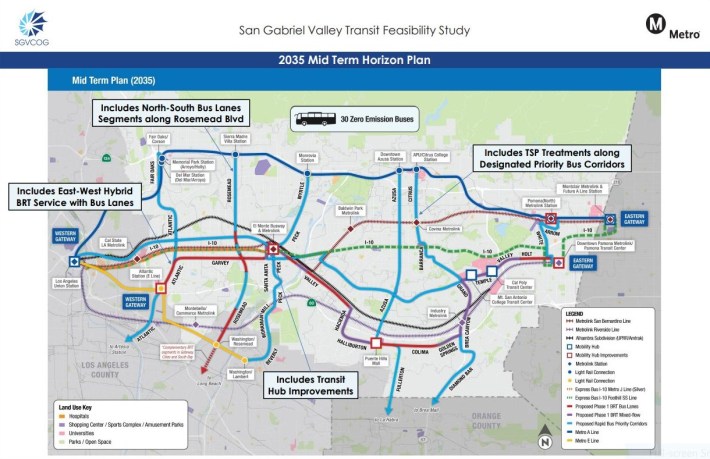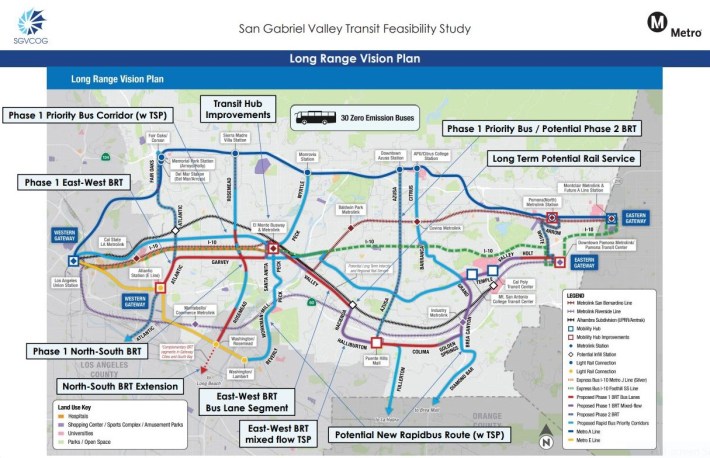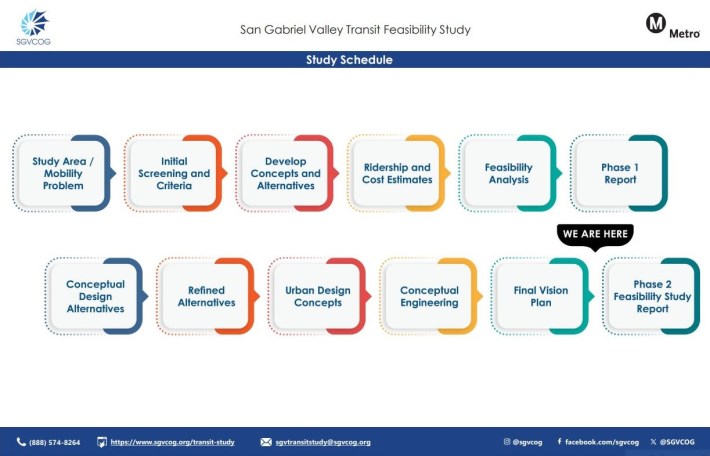Why didn’t the SGV Transit Feasibility Study include dedicated Bus Rapid Transit lanes on Valley Boulevard in Alhambra?
Alhambra resident Xana Hermosillo has been pondering some version of that question since November 29 when the San Gabriel Valley Council of Governments (SGVCOG) gave a zoom presentation on a BRT project coming to the southern part of the region.
The SGV BRT project has Metro funding: $635 million from the canceled proposal to extend the Eastside E Line train along the 60 Freeway. The COG study calls for a mixture of BRT facilities throughout the corridor (some dedicated bus lanes/some mixed-flow lanes), running from Monterey Park to Pomona.

For the midterm vision plan set for 2035, the western stretch of Valley in Alhambra is a “rapid bus priority” street but not part of the main BRT route which runs south of Alhambra - in Monterey Park on Garvey Avenue and Atlantic Boulevard. As a bus priority corridor in Alhambra, the study doesn't call for BRT upgrades on Valley - no bus lanes, just signal priority.
East of El Monte – where Valley is closer to the 60 where the abandoned rail project would have been – much of that street would have dedicated bus lanes. On a long term, unfunded “wish list” plan set for 2050, the vague possibility of BRT lanes further west on Valley has been mentioned, though it doesn’t seem to be demarcated on the concept map.

In November, when SBLA covered the plan, engineering firm Kimley-Horn’s Project Manager Brent Ogden said, “With regard to Valley Boulevard in Alhambra, the city indicated to us that the improvements that they're currently planning to implement along Valley Boulevard would preclude the installation of bus lanes in that jurisdiction.” Ogden’s quote is reflected in the Transit Feasibility Study on pages 1, 3, 34, & 58, but these are not direct quotes from the city of Alhambra.

On February 26, when the COG’s Manager of Transportation Roy Choi came to Alhambra City Council to discuss the project (soon to transition to phase 2, see above), Hermosillo put her question another way.
“Why is a dedicated BRT lane not in this 2035 plan that's about to be finished?” asked Hermosillo of Valley in her city. “And why did the city of Alhambra say no to it?”
The Councilmembers seemed a bit flummoxed. Adele Andrade-Stadler was the first to respond. “There are a couple of things that we really wanted to see happen with Metro and buses. And one of them was to have a bus down Valley Boulevard [...] I don't know who eliminated this.”
“If I may clarify,” responded Choi, “part of the process when we screened, refined, and narrowed down the alternative [concepts] – which eliminated the option of BRT along [west] Valley for the midterm – wasn't just based on feedback from and concerns that were noted from the staff here at the city. We also looked at the qualitative and quantitative data, and there was slightly higher ridership along Garvey instead of Valley. And not only that, but geographically, Garvey is further south and a little bit closer proximity-wise to the 60 Corridor. So it ticked off all the metrics.”
But there was still confusion on the dais about whom the opposition may have come from in the first place. Then City Manager Jessica Binnquist spoke up. Her name is in the study (page 1), listed as a staffer who commented on concepts designed by Kimley-Horn, the same firm that’s redeveloping the 710 Stub for Alhambra.
For the study, Binnquist submitted a letter that, while not explicitly opposing BRT in Alhambra, requested Choi and the COG pursue BRT routes outside the city.
“The city never did take a position on BRT.” Binnquist said. “Our only position on BRT was with regard to the 710 EIR [Environmental Impact Report]. And at that point, we were wholly in favor of the 710 tunnel, and not the light rail or the BRT options. Other than that, the Council has never taken a position and [...] the city of Alhambra staff would never take a position or put anything in writing opposing a regional project without bringing it back to the Council for the Council to take a position. That's the policymakers’ role in all of this and certainly not staff's.”
At this point, Councilmember Sasha Renee Perez stepped in.
“I'm a little bit frustrated,” Perez began. “I just want to make sure that you’re aware, Mr. Choi, that we're currently working on an active transportation plan here in Alhambra [to be discussed at Council again on March 11], that we've taken money out of our emergency fund to apply it to the active transportation plan so that we could work on mobility and some of these first-last mile issues here, because this has been a huge priority for us. And know that what you're talking about here in this proposed BRT lane, particularly on Valley – these are really the opportunities that we're looking for here in Alhambra. [...] We are trying so hard to get folks out of their car and walking throughout our city, either by foot, or riding bicycles, and having a connection in particular to an area like Union Station. This is the exact kind of resource that we're looking for. So I was very confused when this discussion first came up. And it was actually transportation advocates who I've been working closely with that made me aware that it was being said that Alhambra was in opposition to BRT. And I immediately became alarmed because myself and Councilmember [Jeff] Maloney have been working on a subcommittee for the past two years to try to make our city less car centric. So it seemed very strange that this was being described as a position on behalf of the city when we -- I didn't even know it was being discussed or being talked about. So, I just want to understand from you, why?”
Choi responded, “So city staff is correct. There was no hard line against BRT that was voiced to the COG, nor our study team. However, we did hear some concerns about being within proximity of the 710 and where it terminates and where the traffic from the freeway spills over onto Valley Boulevard."
Note that Alhambra has been planning to retool that 710 terminus, potentially including removing the freeway stub. Immediately west of the present stub, the city of Los Angeles is planning a project that would add bus lanes on Valley Boulevard.
Choi continued, "And so there were some concerns about the general traffic conditions along Valley. So when we looked at the screening analysis, and we looked at the quantitative metrics for ridership, also the travel times, and also the proximity, and the goals of the project, it was basically to replace the lost services along the 60 corridor for the Metro Motion.”
Perez then wanted to know how likely it is that Alhambra will see dedicated BRT lanes on West Valley by 2050.
Choi replied, “During the environmental process, it would be a function of the other cities [in the plan] opting out of pursuing their BRT alignments that they had approved as part of the feasibility analysis. [...] At that time, as part of the scoping process, we would engage with the cities again. And if there was a desire from the city of Alhambra [...] I think we would have an option to have a better in depth conversation [...] It's a bunch of if’s, when’s, and maybe’s, but I'm hopeful that there is an opportunity in the future, especially in the long term.”
The timeline of such changes though, would also depend on whether any sections of the project get funded for a jumpstart in anticipation of the 2028 Olympics. Reminder: spectators will only be allowed to attend the games via transit or active transportation.

Perez asked if there was anything the city could do in the meantime to bolster its chances, such as coordinating the development of its active transportation plan to accommodate BRT lanes on Valley.
“Those aren't things that we can promise.” Choi said. “So I think the only thing that we can do in the interim to help move the stone a little bit further so that you guys in the city are provided some semblance of a plan for BRT along Valley, would be reaching out to Metro and discussing the need for Valley, the city's desire to have BRT in there. And we can initiate that discussion and see where that goes.”
Streetsblog’s San Gabriel Valley coverage is supported by Foothill Transit, offering car-free travel throughout the San Gabriel Valley with connections to the Gold Line Stations across the Foothills and Commuter Express lines traveling into the heart of downtown L.A. To plan your trip, visit Foothill Transit. “Foothill Transit. Going Good Places.”Sign-up for our SGV Connect Newsletter, coming to your inbox on Fridays!







